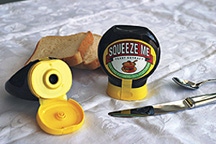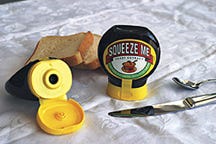Squeezable jar turns Marmite upside-down
January 30, 2014


Updating an old product's packaging may not make it taste better, but it can make it easier to use for those who love it. Packaging professionals, however, face the challenge of protecting contents in transparent plastic containers against light-induced degradation to maintain the quality of the product. Recently, Unilever, owner of the Marmite brand of food spread, wanted to change the spread's package to meet consumer demand for easy-to-use, break-resistant packaging, yet still keep the distinctive jar's look. Marmite started life in 1902, when the Marmite Food Extract Co. Ltd. started its life with an idea to produce a food spread from a yeast by-product of the brewing industry. The dark brown-colored Marmite is a savory spread that has a strong, slightly salty flavor—definitely a love-it-or-hate-it type of food. Because of its health value (e.g. its high content of vitamin B), children in Britain are often fed Marmite and many never grow out of the habit of eating it.
Since it was first introduced, Marmite has changed little, and neither has its packaging. Originally packaged in a small earthenware pot, similar to a kind of French casserole dish called a 'Marmite', (pronounced MAR-MEET), the spread was later packaged in a 57-g, 2.5 in.-high, bulb-shaped glass jar with a distinctive yellow lid. The jar's shape and distinctive red and yellow label has remained pretty much the same, until now.
To meet consumer demand, Unilever came up with a new concept, commissioning designer Peter Chapman's Innovation Generation (www.innovationgeneration.co.uk) to manage all aspects of the packaging extension. They created an upside-down solution by “up-ending” Marmite's traditional amber glass jar to an inverted squeeze bottle of polyethlene terephthalate with a cap with a valve. ALPLA (www.alpla.com), a leader in plastic packaging technology, injection stretch/blow- molds the jar of PET for its glass-like look and squeezability. But PET has only inherent UV light protection, up to 320 nm. The vitamins in Marmite are generally sensitive to light. Riboflavin, one of the spread's key ingredients, is highly sensitive to light up to 500 nm. To protect Marmite from light's damaging effects, ALPLA added Ciba Specialty Chemicals' (www.cibasc.com/shelfplus) customized SHELFPLUS® light-filter solution, a resin additive that blocks light up to 500 nm, much higher than other existing solutions, and thus protect Marmite from the degradation of its B vitamins. But the SHELFPLUS UV filters were further developed to keep the transparency level of the jar high.
A SimpliSqueeze cap in yellow polypropylene with a silicone valve system from Seaquist Closures (www.seaquistclosures.com) makes dispensing the product easy. The valve seals to ensure clean product cutoff without messy buildup around the orifice. The 200-g “Squeeze Me” package was so well received that Unilever has also added a 400-g size.
You May Also Like


